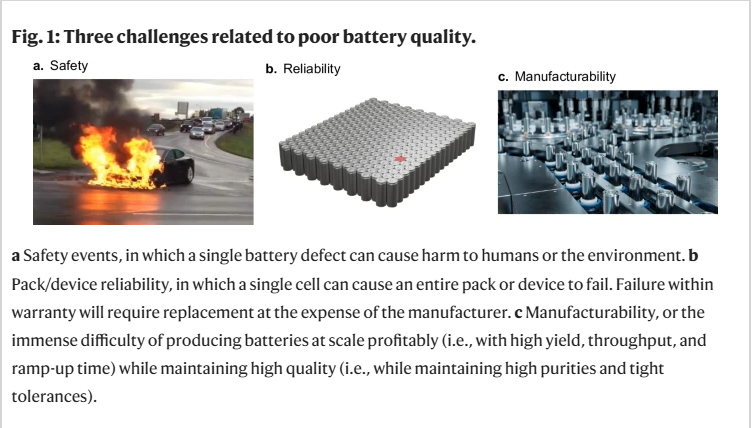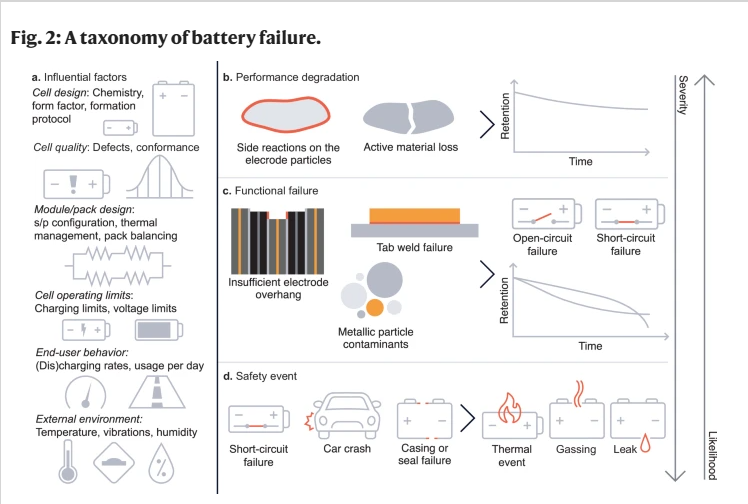Challenges and opportunities for high-quality battery production at scale
Abstract
As the world electrifies, global battery production is expected to surge. However, batteries are both difficult to produce at the gigawatt-hour scale and sensitive to minor manufacturing variation. As a result, the battery industry has already experienced both highly-visible safety incidents and under-the-radar reliability issues—a trend that will only worsen if left unaddressed. Here we highlight both the challenges and opportunities to enable battery quality at scale. We first describe the interplay between various battery failure modes and their numerous root causes. We then discuss how to manage and improve battery quality during production. We hope our perspective brings greater visibility to the battery quality challenge to enable safe global electrification.

Introduction
We currently live in exciting times for the battery industry. In light of the increasingly visible impacts of climate change1, consumer, corporate, and governmental support for electric vehicles (EVs) and stationary energy storage is crescendoing2,3. The industry is projected to grow by 30% per year until 20304. A planetary-scale energy transition is well underway, requiring unprecedented volumes of battery-powered energy storage.

However, the global battery production ramp is threatened by looming challenges. While concerns around the materials supply chain and the “valley of death” for new battery concepts are now well-established5,6, we highlight an equally important but less frequently discussed risk: poor battery quality and its impacts on battery safety, reliability, and the financial success of cell manufacturing (Fig. 1). Indeed, since the commercialization of lithium-ion battery technology in 19917,8, several high-profile safety events (Fig. 1a) have occurred in sectors such as consumer electronics, electric micromobility, EVs, aviation, and medical devices9,10. One infamous EV safety case required a USD $1.9B fleetwide recall11,12. Unfortunately, as applications of battery technology have proliferated, the incidence rate of catastrophic events appears to be increasing; for instance, hundreds of electric bike fires have occurred over the past few years in New York City alone, triggering legislation13. Underestimating these battery safety risks will have devastating financial, human, and environmental costs and jeopardize consumer and regulatory confidence in battery technology.
Aside from headline-grabbing safety events, battery quality issues can have outsize impacts on the reliability of battery-powered devices (Fig. 1b). For instance, an EV pack typically consists of hundreds or thousands of cells arranged in series and in parallel, often combined into modules. (Although we focus on EVs in this article, these principles apply to any battery-powered device). These configurations determine the sensitivity of the pack to cells that exhibit either open-circuit failure, short-circuit failure, or even heterogeneity. A cell that exhibits open-circuit failure will cause all cells connected to it in series to become inoperable (similar to series-connected Christmas tree lights)14,15,16. A cell that exhibits short-circuit failure will cause all cells connected to it in series to overcharge17 and cause all cells connected to it in parallel to discharge into it in order to maintain the same voltage14,17—not to mention the risk of short-induced thermal runaway propagating to neighboring cells18,19,20. Additionally, but less critically, variability in initial cell energy and cell aging can cause a pack to underperform relative to an otherwise identical pack with no cell-to-cell variability21,22,23. While these issues can be partially managed by hardware- and software-based pack balancing strategies, these approaches add mass and complexity to pack design and are often insufficient to manage severe issues15,16. In summary, the failure of a single cell can cause complete pack failure.
The core challenge underlying these safety and reliability issues is the unforgiving requirements of battery production at scale (Fig. 1c): namely, high production yields and throughputs along with extreme tolerance and purity specifications. A large Western 38 GWh/year battery gigafactory produces six million cylindrical cells per day—or nearly 70 cells per second24. Simultaneously, modern batteries must be manufactured to geometric tolerances on the order of a few microns while avoiding a host of similarly-sized particle contaminants25,26,27. Ensuring that each cell meets these specifications while being manufactured at high rates across multiple production lines that are continuously modified, maintained, and upgraded is a colossal task6,24,28. Thus, quality control is a key differentiator between top-tier and bottom-tier cell producers. Ultimately, given the inevitable quality obstacles faced during large-scale battery production, both cell producers and original equipment manufacturers (OEMs; in this context, the manufacturers of any battery-powered device) must learn to understand and manage this issue.
Based on our experiences in the battery industry, we believe ensuring battery quality at scale is perhaps the most important technical challenge hindering the ability to rapidly ramp battery production in the years to come. Yet a comprehensive framework and vision for quality in the battery industry is in its infancy. In this perspective, we share our outlook on the challenges and opportunities for enabling battery quality at scale. First, we define battery quality and its relationship to other key attributes such as lifetime, failure, safety, reliability, and manufacturing performance. We then outline the difficult options available for managing and improving battery quality during cell production. We hope our perspective sheds light on this critical challenge and catalyzes a broader acceptance of its importance for an electrified future.
More detail: Challenges and opportunities for high-quality battery production at scale
About Neware Technology Ltd:
Neware was founded in 1998. We are trusted by ATL, BYD, CATL, Tesla, Apple, HUAWEI, SolarEdge, etc. We provide battery testing solutions for testing battery cell, module, pack, supercapacitor, BESS, etc. If you want to do capacity, cycle life, pulse, DCIR, GITT, HPPC, or EV driving simulation test, please feel free to contact us.
